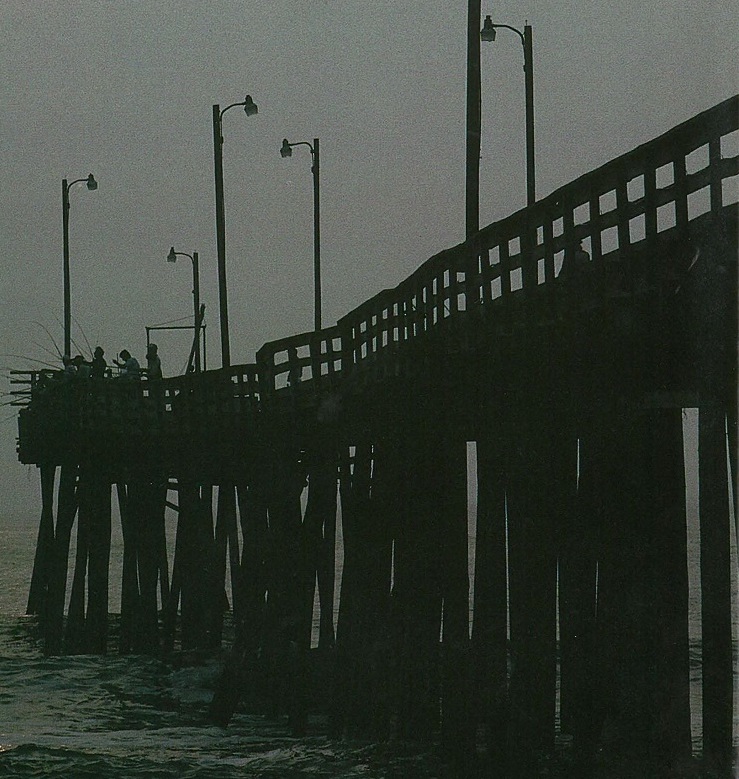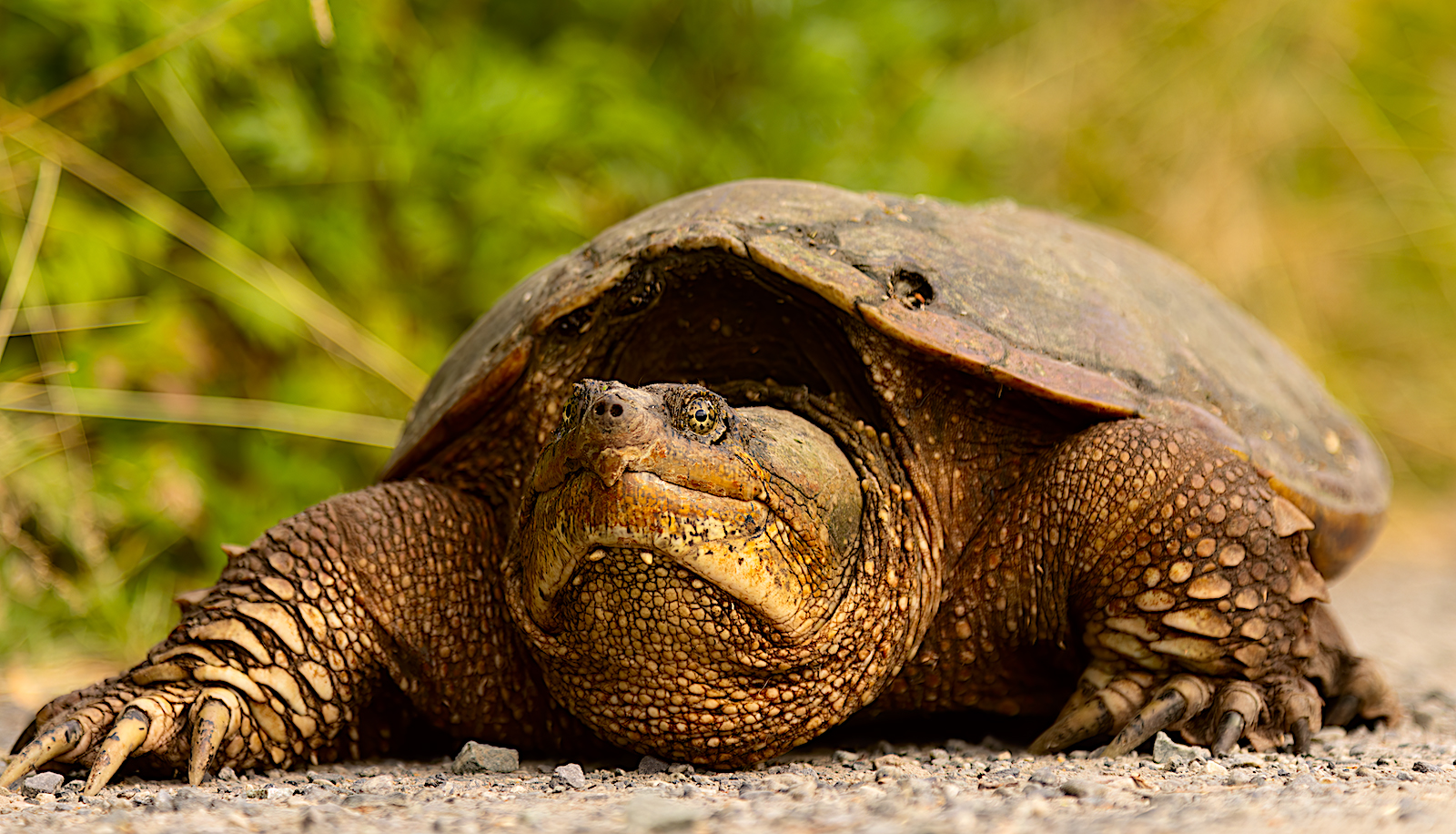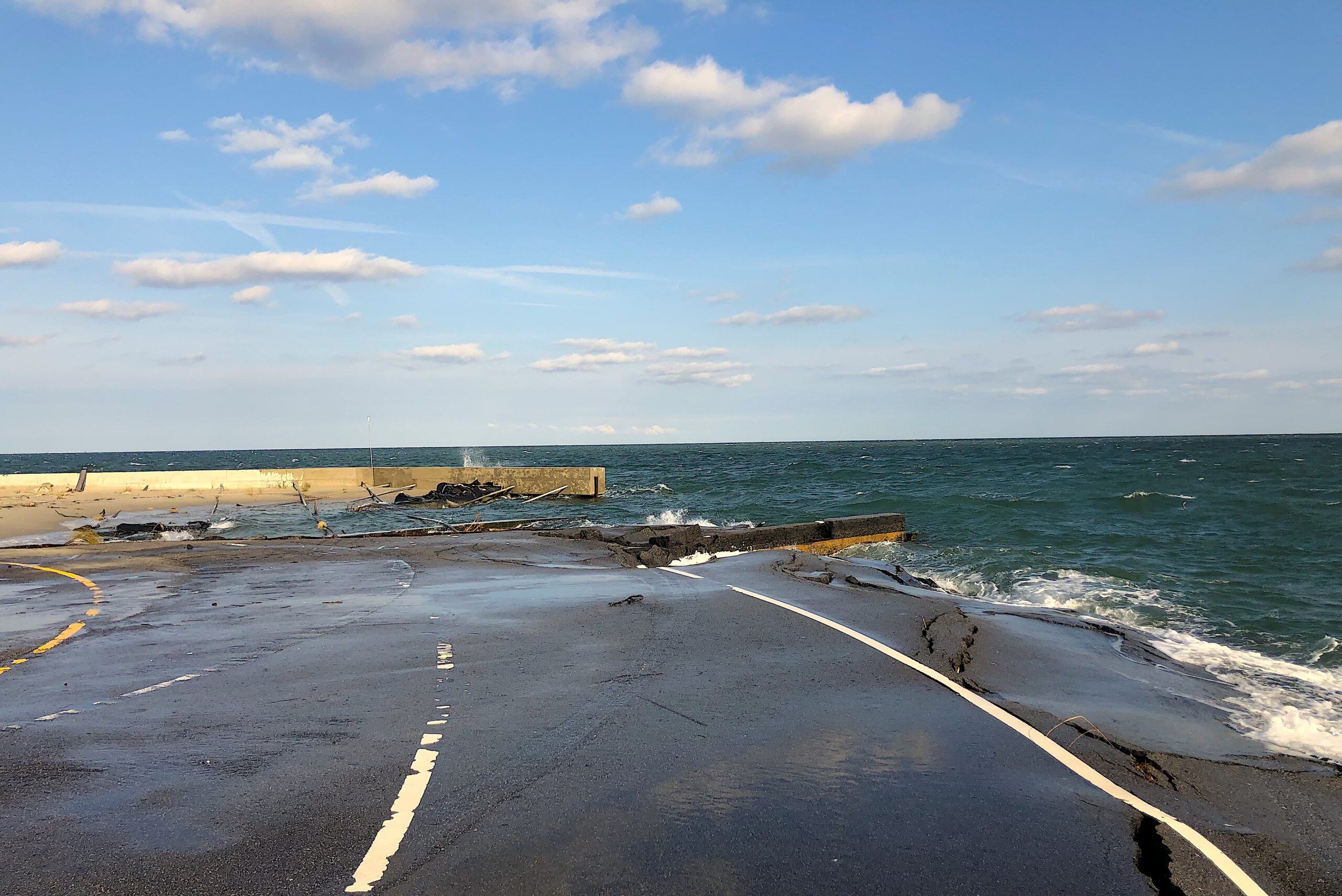As the sun begins to cast a metallic glaze over the deep blue water around Nags Head Fishing Pier, Jessica Massie dangles her rod over the wooden railing into more than 16 feet of water.
Standing elbow-to-elbow next to a row of men a head taller than she is, Jessica, 12, reels in the line. Then she throws her line back into the water so fast that it looks like it is dancing.
After many tries, she feels a jerking motion on the end of the line. Jessica’s friend Sam Phillips helps her pull in the first fish she ever caught.
“This is exciting,” says Jessica of Waynesboro, Va., while holding up a shiny bluefish. “I have been fishing a lot and never caught anything before.”
After Jessica pulls in her prized 12-inch bluefish, almost a dozen anglers throw in their lines near the end of the pier. Within a few minutes, several bluefish are fluttering on the pier’s wooden floor.
“It’s either feast or famine at a fishing pier,” says Billy Sizemore of Stephenson, W. Va. “When you see someone hook a fish,” you might see 15 lines go into the water.
For Sizemore and others, pier fishing has become a summertime ritual. Fall is prime fishing season for red drum and other fish.
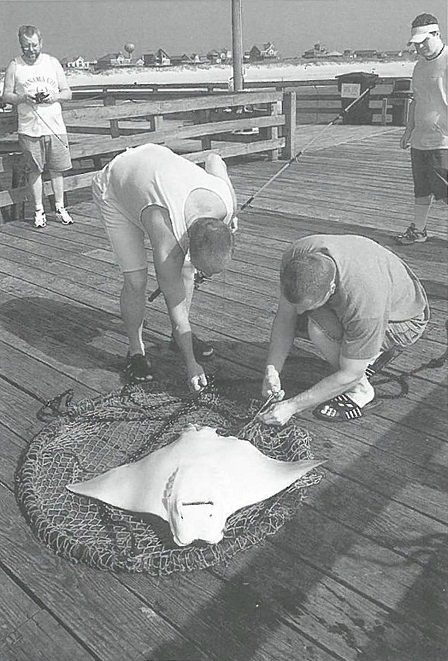
“I come here every day,” says Al Mintor of West Virginia, who spends the summers at Kill Devil Hills. “I like this pier. It is where I have the best luck. I caught four or five bluefish today. It is relaxing because there are no wives or telephones.”
Mary Nelson, a clerk at Nags Head Fishing Pier, says anglers become attached to one pier and do all their fishing from there.
“l know from being at different piers that they pick one pier, and you can’t pry them off of it,” says Nelson.
Ocean pier fishing attracts anglers for a number of reasons. “It is entry-level fishing and economical,” says Andy McCann, owner of Nags Head Pier. “It is easy, and you don’t have to have a cast. You can just let a line drop straight down.”
In North Carolina, 25 public fishing piers dot the coastline — from Avon to Sunset Beach — according to the N.C. Division of Marine Fisheries (DMF).
This is a decrease from 34 piers documented in 1962 in Robert J. Goldstein’s Coastal Fishing in the Carolinas From Surf, Pier and Jetty. Many have been destroyed by hurricanes and not rebuilt.
“The number of piers has declined because it is costly to rebuild them,” says McCann.
With booming development along the coast, Mike Robertson, owner of Kure Beach Pier, says that some communities do not support public piers.
“A lot of communities are looking down on piers,” says Robertson. “Now that communities are maturing, they don’t want to put up with blue-collar guys. A lot of professional people just want to stand behind a plate glass window at a motel and drink Scotch.”
Despite the stereotypical image of a fisher, piers draw a cross section of people — from professionals and blue-collar workers to students and young children.
“You always notice the diversity of people,” says Mintor. “It is like going in a Wal-Mart.”
Many anglers are regulars who arrive when the sun begins to rise — and just as the fish are starting to bite. They cart the fishing gear in a variety of a ways — from little red wagons usually used for kids’ play to luggage carts.
Six days a week, the Rev. Brad Bradshaw, the minister of Kitty Hawk Methodist Church in Kitty Hawk, rolls his cooler down the pier. He usually fishes near the front of the pier and uses plastic grub to fish for trout or other bottom fish.
“I come for the people more than the fish,” says Bradshaw. “Fishing is sometimes the only quiet that I get. It is a great place to drop your blood pressure.”
For the larger fish, including kingfish or king mackerel and Spanish mackerel, regular anglers like Mintor gather at the end of the pier.
Mintor works hard to catch fish. He practices a special technique called plugging in which he is constantly casting and retrieving his line.
“We twitch the line and try to make it dance,” he says. “We are trying to duplicate the way a living fish tries to find food.”
Some regulars, like Skip Coup of Knightdale who is fishing for king mackerel, have two fishing rods dangling in the water. One of Coup’s rods has an anchor. The other has live bait. The two lines are attached with a special handmade rig.
“The rig gives me visibility,” says Coup. “I use a 10-gauge wire and bobber weight for my rig. It is stronger than a clothespin. When the fish takes the bait, the two lines unsnap.”
Shark Fishing
On summer nights, shark fishers also congregate at piers. Although shark fishing is legal in North Carolina, only a few piers allow it, usually from after dusk to dawn.
“Shark fishing is almost a thing of the past,” says Avon Pier manager Billy Hawkins as he points to a shark’s head on the wall. “It is a lot of trouble getting the head out of the water. We have one fisherman who comes down once a year and tags sharks.”
Once a week, David Wolfe of Grandy fishes for sharks off the end of Jennette’s Ocean Pier in Nags Head.
“It is an inexpensive way to catch big fish without going out in a boat,” says Wolfe. “I have caught sharks up to 500 or 600 pounds.”
Wolfe learned the art of shark fishing many years ago from a friend. “It is like deer hunting,” he says. “Fifty will try it, and only one will stick with it. It requires a lot of patience.”
To catch sharks, Wolfe uses special equipment and bait. As the waves rock against the pier pilings, he launches a spider kite — which is attached to a lollipop and line baited with a five-pound tuna head — 300 feet away from the pier. As soon as the lollipop melts, the kite flies away, and the line stays in the water.
After waiting several hours on the end of the pier, Wolfe doesn’t catch anything. However, the week before he had pulled in a 190-pound sand tiger.
When Wolfe does pull in a shark, he says the tug on the reel creates a “screaming noise so loud that is can be heard down to the pier house.”
Usually a crowd congregates while Wolfe gathers special equipment to reel in the big catch. First, he straps on a harness around his waist and then uses a clip rope to pull the shark onto the beach.
Even for an experienced angler like Wolfe who averages three sharks a season — eight during a good year — shark fishing can be dangerous. One time, he broke his ribs while pulling in a shark.
“Once I was on another pier and my reel went off,” says Wolfe. “I put on my harness and thought it was a small shark. I got thrown up against the railings.”
In July, the DMF began restricting commercial and recreational shark harvest in state waters.
Commercial fishers have a bycatch limit of one shark per vessel per day and limited seasons for certain species.
Recreational fishers are allowed only one shark per person per day on a fishing pier or one per vessel per day. AU sharks except Atlantic sharpnose or Rhizoprionodon terraenovae must be a minimum of 54 inches from the nose to the tail’s fork. AU other species over 84 inches from the nose to the tail’s fork are prohibited except the tiger species or Galeocerdo curvier, thresher or Alopia vulpinus, bigeye thresher or Alopias supercilliosus, shortfin mako or lsurus oxyrinchus and hammerhead or Sphyrna species.
In addition, any shark not retained must be returned to the water in a manner that ensures survival. Any shark retained must have head, tail and fins intact.
North Carolina law states that any species that has a minimum size or bag limit cannot be mutilated.
“These measures are intended to protect juvenile and immature sandbar sharks and juvenile, immature and mature dusky sharks by reducing the direct and incidental harvest of sharks,” says Jim Francesconi, a DMF fisheries biologist.
“We also are trying to stop the practice of finning sharks — removing the fins and discarding the carcass — within state and federal waters.”
Fall Fishing
Summer isn’t the only time that anglers gather on piers. The biggest time of year for pier fishing is fall — September through mid-October.
“This is when adult fish move down the beach to spawn in and around inlets,” says Jim Bahen, a North Carolina Sea Grant fisheries specialist. “The big spots are running. The water is just right for king mackerel.”
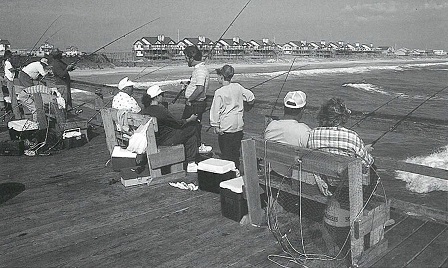
Along the Outer Banks, red drum fishing has become a fall tradition. The world record for red drum — 94.2 pounds — was set 100 yards from Avon Pier.
“Drum fishing is like a ritual,” says Hawkins. “People don’t see each other all year. It is just like a club. They come from all over the country. One guy comes from Texas. They fish all day and night.”
In the fall, subsistence fishers also flock to Outer Banks piers to stock up on spot for winter food.
“Some people still fish to supplement their pantry,” says Norman Bradford, who serves on the North Carolina Marine Fisheries Commission’s Northeast Regional Advisory Panel. “They salt the spot down or will freeze it and use it in the winter.”
Anglers aren’t the only ones who congregate at piers. During summer evenings, there are as many spectators as fishers. Most piers charge a nominal amount for sightseers.
At Nags Head Pier, the spectators include a young college couple who sit on a wooden bench and watch the seagulls flutter over, and a large stingray being pulled in.
“It is fun because you get to see a lot of interesting stuff,” says Jackie Black, an Allegheny College student who is dressed in black sequined jeans. “You might get to see a shark come around or see someone clean fish.”
First Public Pier at Kure Beach
In North Carolina, public fishing piers became popular during the early part of the 20th century. Built in 1923, Kure Beach Pier is the oldest in the state and possibly on the Atlantic Coast, according to Coastal Fishing in Carolinas From Surf, Pier and Jetty.
“The first pier was 120 feet long and 22 feet wide,” according to the Kure Beach Pier’s Web site. “Pier poles were cut from the forest along the river and used as pilings.
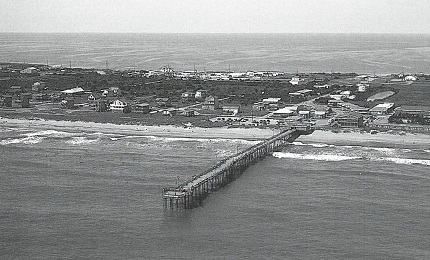
“Because very little was known about sea worms or other marine borers, the pier fell down or was destroyed the first year.”
Since then, the Kure Beach Pier has been rebuilt many times after hurricane damage, including major damage from Hurricane Hazel in 1954. In 1984, Hurricane Diana took about half the length of the pier.
In North Carolina, piers usually stretch 400 to 1,000 feet long over the ocean. “On the northern end, the piers are shorter because the water is deeper,” says McCann.
Most of the piers look alike with wooden benches, lights and large basins for washing fish. They are attached to tackle shops, and some have full-service restaurants.
At Nags Head Pier, customers are greeted by a sign: “Happiest People in the World Pass Through This Door!”
Inside the wooden-paneled tackle shop, a fishing board boasts some of the recent catch —from an 18 3/4-inch trout to a 26 3/4-inch puppy drum. Another board shows when low and high tide is expected. Behind a counter, there is a wide selection of artificial bait, tackle, rods and other fishing equipment.
On the other side is a restaurant where customers can order hot or cold food.
“We have one gentleman who comes to the pier every morning,” says McCann. “He always stops in the restaurant and talks to the waitresses. He comes to the pier more to talk than fish.”
During the summer, some parents drop off their kids for the day. “In 15 years, we have raised a lot of kids,” says McCann.
Fourteen-year-old Andrew Palomares is a regular at Avon Pier during the summer months. He either works at the tackle and souvenir shop — where he swaps fishing stories with Billy Hawkins — or fishes on the pier.
“I got a 115-pound ray,” says Palomares. “I wrestled with it for l 1/2 hours until I got it in. It was as big as this table. Tonight I am going to fish for 24 hours straight.” Palomares isn’t the only diehard fisher who spends the night on the pier.
“We have had people stay for three to four days on our pier,” says Hawkins. “We had one man who didn’t leave the pier for a month. One even brought a styrofoam mattress. Some set up their sleeping bags like a tent.”
This article was published in the Autumn 2000 issue of Coastwatch.
For contact information and reprint requests, visit ncseagrant.ncsu.edu/coastwatch/contact/.
- Categories:
